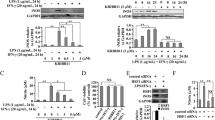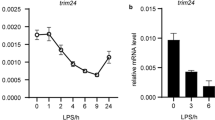Abstract
The heat shock transcription factor (HSF) is an important transactivator of the heat shock genes. Recent studies have shown that HSF1 acts as a repressor of non-heat shock genes to protect against endotoxemia. In this study, we found that heat shock treatment and HSF1 over-expression augmented the induction of interleukin (IL)-10 mRNA. Computational analysis of the mouse IL-10 promoter region showed that three potential heat shock elements (HSEs) were located at mouse IL-10 gene promoter, among which only the −387/−360 probe formed a complex with HSF1. The lack of binding of the other two HSEs to HSF1 suggested the critical role of the flanking sequences in the binding specificity of HSE to HSF1. Moreover, we showed that HSF1 overexpression transactivated mouse IL-10 gene promoter and this transcriptional activation was inhibited by the mutation of HSE in the −387/−360 region of IL-10 gene promoter using luciferase reporter assay. These findings indicate that HSF1 is a transcriptional activator of anti-inflammatory mediator IL-10 gene in RAW264.7 macrophages.




Similar content being viewed by others
REFERENCES
Anckar, J., and L. Sistonen. 2011. Regulation of HSF1 function in the heat stress response: implications in aging and disease. Annual Review of Biochemistry 80: 1089–1115.
Wu, C. 1995. Heat shock transcription factors: structure and regulation. Annual Review of Cell and Developmental Biology 11: 441–469.
McMillan, D.R., X. Xiao, L. Shao, K. Graves, and I.J. Benjamin. 1998. Targeted disruption of heat shock transcription factor 1 abolishes thermotolerance and protection against heat-inducible apoptosis. Journal of Biological Chemistry 273: 7523–7528.
Perisic, O., H. Xiao, and J.T. Lis. 1989. Stable binding of Drosophila heat shock factor to head-to-head and tail-to-tail repeats of a conserved 5bp recognition unit. Cell 59: 797–806.
Cahill, C.M., W.R. Waterman, Y. Xie, P.E. Auron, and S.K. Calderwood. 1996. Transcriptional repression of the prointerleukin 1beta gene by heat shock factor 1. Journal of Biological Chemistry 271: 24874–24879.
Singh, I.S., R.M. Viscardi, I. Kalvakolanu, S. Calderwood, and J.D. Hasday. 2000. Inhibition of tumor necrosis factor-alpha transcription in macrophages exposed to febrile range temperature. A possible role for heat shock factor-1 as a negative transcriptional regulator. Journal of Biological Chemistry 275: 9841–9848.
Singh, I.S., J.R. He, S. Calderwood, and J.D. Hasday. 2002. A high affinity HSF-1 binding site in the 5′-untranslated region of the murine tumor necrosis factor-alpha gene is a transcriptional repressor. Journal of Biological Chemistry 277: 4981–4988.
Xie, Y., C. Chen, M.A. Stevenson, P.E. Auron, and S.K. Calderwood. 2002. Heat shock factor 1 represses transcription of the IL-1beta gene through physical interaction with the nuclear factor of interleukin 6. Journal of Biological Chemistry 277: 11802–11810.
Zhang, L., M. Yang, Q. Wang, M. Liu, Q. Liang, H. Zhang, and X. Xiao. 2011. HSF1 regulates expression of G-CSF through the binding element for NF-IL6/CCAAT enhancer binding protein beta. Molecular and Cellular Biochemistry 352: 11–17.
Del Prete, G., M. De Carli, F. Almerigogna, M.G. Giudizi, R. Biagiotti, and S. Romagnani. 1993. Human IL-10 is produced by both type 1 helper (Th1) and type 2 helper (Th2) T cell clones and inhibits their antigen-specific proliferation and cytokine production. Journal of Immunology 150: 353–360.
Kuhn, R., J. Lohler, D. Rennick, K. Rajewsky, and W. Muller. 1993. Interleukin-10-deficient mice develop chronic enterocolitis. Cell 75: 263–274.
Dai, W.J., G. Kohler, and F. Brombacher. 1997. Both innate and acquired immunity to Listeria monocytogenes infection are increased in IL-10-deficient mice. Journal of Immunology 158: 2259–2267.
Moore, K.W., R. de Waal Malefyt, R.L. Coffman, and A. O’Garra. 2001. Interleukin-10 and the interleukin-10 receptor. Annual Review of Immunology 19: 683–765.
Powell, M.J., S.A. Thompson, Y. Tone, H. Waldmann, and M. Tone. 2000. Posttranscriptional regulation of IL-10 gene expression through sequences in the 3′-untranslated region. Journal of Immunology 165: 292–296.
Liu, Y.W., H.P. Tseng, L.C. Chen, B.K. Chen, and W.C. Chang. 2003. Functional cooperation of simian virus 40 promoter factor 1 and CCAAT/enhancer-binding protein beta and delta in lipopolysaccharide-induced gene activation of IL-10 in mouse macrophages. Journal of Immunology 171: 821–828.
Wong, H.R. 1999. Heat shock proteins. Facts, thoughts, and dreams. A. De Maio. Shock 11:1–12, 1999. Shock 12: 323–325.
Klosterhalfen, B., S. Hauptmann, L. Tietze, C. Tons, G. Winkeltau, W. Kupper, and C.J. Kirkpatrick. 1997. The influence of heat shock protein 70 induction on hemodynamic variables in a porcine model of recurrent endotoxemia. Shock 7: 358–363.
Villar, J., S.P. Ribeiro, J.B. Mullen, M. Kuliszewski, M. Post, and A.S. Slutsky. 1994. Induction of the heat shock response reduces mortality rate and organ damage in a sepsis-induced acute lung injury model. Critical Care Medicine 22: 914–921.
Snyder, Y.M., L. Guthrie, G.F. Evans, and S.H. Zuckerman. 1992. Transcriptional inhibition of endotoxin-induced monokine synthesis following heat shock in murine peritoneal macrophages. Journal of Leukocyte Biology 51: 181–187.
Wang, Y., C. Li, X. Wang, J. Zhang, and Z. Chang. 2002. Heat shock response inhibits IL-18 expression through the JNK pathway in murine peritoneal macrophages. Biochemical and Biophysical Research Communications 296: 742–748.
Shi, Y., Z. Tu, D. Tang, H. Zhang, M. Liu, K. Wang, S.K. Calderwood, and X. Xiao. 2006. The inhibition of LPS-induced production of inflammatory cytokines by HSP70 involves inactivation of the NF-kappaB pathway but not the MAPK pathways. Shock 26: 277–284.
Amin, J., J. Ananthan, and R. Voellmy. 1988. Key features of heat shock regulatory elements. Molecular Cell Biology 8: 3761–3769.
Brightbill, H.D., S.E. Plevy, R.L. Modlin, and S.T. Smale. 2000. A prominent role for Sp1 during lipopolysaccharide-mediated induction of the IL-10 promoter in macrophages. Journal of Immunology 164: 1940–1951.
Benkhart, E.M., M. Siedlar, A. Wedel, T. Werner, and H.W. Ziegler-Heitbrock. 2000. Role of Stat3 in lipopolysaccharide-induced IL-10 gene expression. Journal of Immunology 165: 1612–1617.
ACKNOWLEDGMENTS
This work was supported by funds from the Major National Basic Research Program of China (2007CB512007). Dr. Benjamin and Joel Pieper from University of Utah provided excellent editorial assistance during preparation of this manuscript.
Author information
Authors and Affiliations
Corresponding author
Rights and permissions
About this article
Cite this article
Zhang, H., Zhang, L., Yu, F. et al. HSF1 Is a Transcriptional Activator of IL-10 Gene Expression in RAW264.7 Macrophages. Inflammation 35, 1558–1566 (2012). https://doi.org/10.1007/s10753-012-9471-4
Published:
Issue Date:
DOI: https://doi.org/10.1007/s10753-012-9471-4




